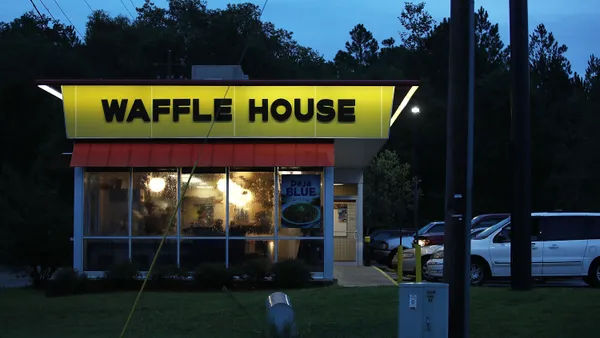Dive Brief:
- Uber announced Wednesday it is adding a Pickup and Go feature to its app that allows rides passengers to order and pick up meals and groceries while en route to their destination. The platform will also allow users to pre-order when a store or restaurant is closed, as well as create multiple orders from different stores and restaurants at the same time.
- Starting in June, users in select cities in the U.S., U.K., Canada, Taiwan and Australia can combine food and grocery orders at no extra charge, according to Business Insider. The grocery side of this feature will initially only be available at convenience stores like 7-Eleven and Wawa that are near the restaurant being ordered from.
- The integration between Uber's ride hailing app and its food delivery arm — the company's most lucrative business this past year — comes as more consumers are getting comfortable traveling and eating outside of the home again.
Dive Insight:
With these new features, Uber is continuing its strategy to link its rides business more closely with Uber Eats as it aims for profitability. According to the company's earnings report in February, more than 10% of new Uber Eats users in Q4 2020 discovered the platform through its ride-hailing app.
Although Uber has yet to make a profit since its founding in 2009, its food delivery arms has reported smaller losses each year. In 2020, Uber Eats' revenue jumped 152% year-over-year to $4.8 billion.
"Throughout the pandemic, we've worked with more than 1 million merchants to help move more than 1.5 billion orders of meals and grocery items," CEO Dara Khosrowshahi said in a video on Uber's website.
Now as restaurant dining rooms are reopening and consumers begin planning events, Uber is providing incentives to encourage Uber Eats customers to engage with its rides business. Beginning in May, Eats Pass members will receive discounts on rides, with 10% off three rides each month. Uber will also ask users booking rides from airports if they would like food or groceries delivered through Uber Eats to their destination. While ordering ahead was an existing option, the prompts are new.
Uber's rides business is already beginning to bounce back. March was the company's best month for its mobility arm since before the pandemic.
By further integrating Uber's ride-sharing and Eats business through the Pickup and Go and bundling features, the company can encourage higher ticket prices while optimizing labor that is already deployed for either service. This would lower Uber's labor costs and potentially inch it closer to profitability. In November, Khosrowshahi said he expects the company's delivery business to become profitable in 2021. This estimation is rosier than pre-pandemic analyst predictions, which pegged Uber Eats to continue losing money on every order until 2024.
These new features follow Uber Eats' launch of its Merchant Stories function earlier this month to help merchants engage with in-app customers. Operators can integrate their Instagram accounts into Uber Eats, allowing them to upload images and text to update users about promotions, menu changes or new services. Thirteen percent of users who clicked through a restaurant's Stories placed an order in the same session, early tests found.
Uber isn't the only third-party delivery aggregator adjusting its business operations in a bid for stronger engagement. Earlier this week, DoorDash debuted a three-tiered commission price structure, likely in the hopes of attracting operators wary of the steep commission fees that aggregators carve out of every order.















